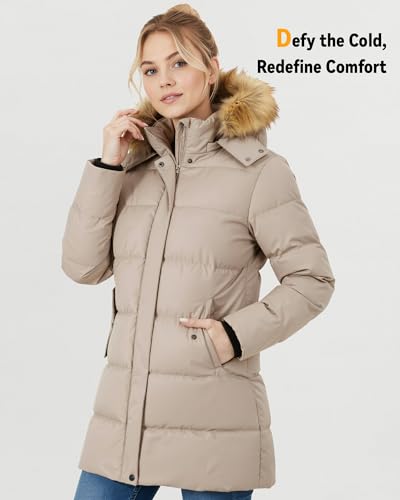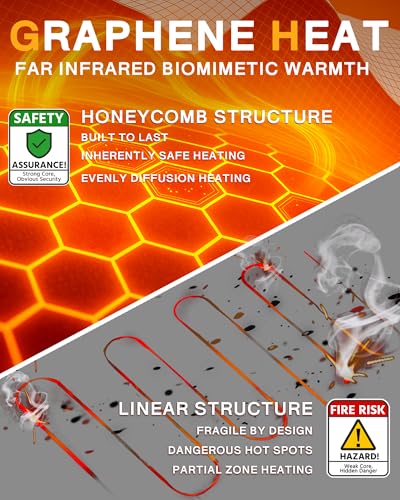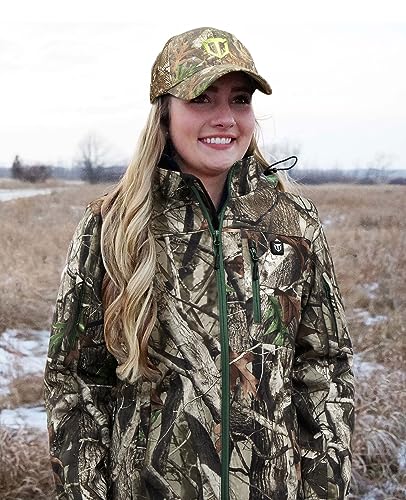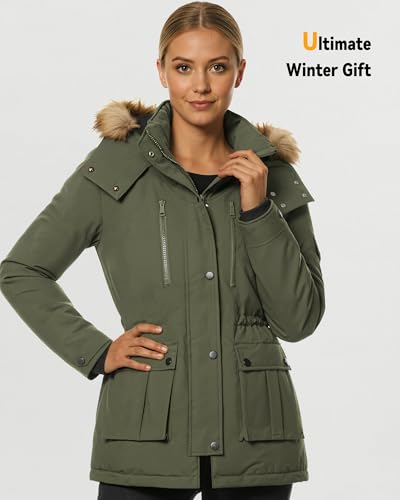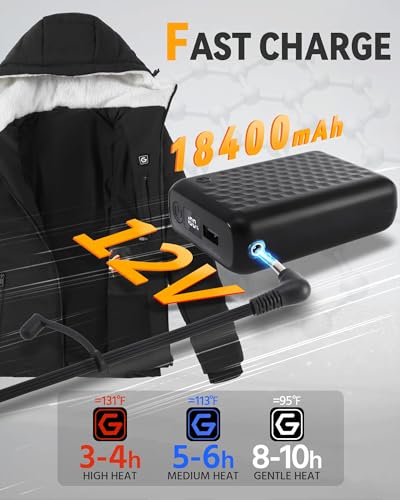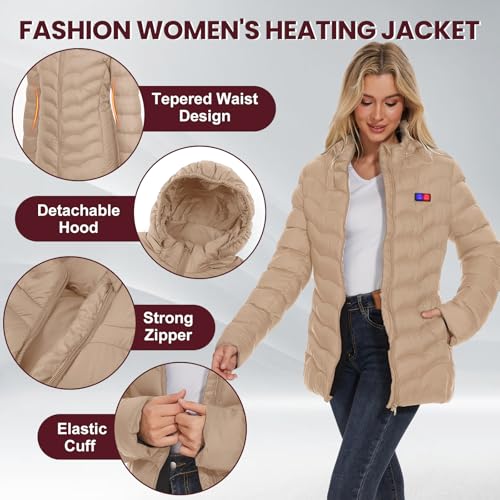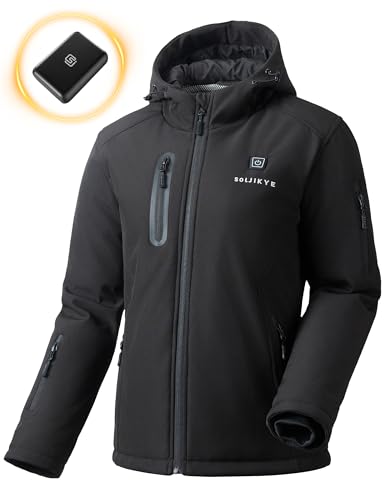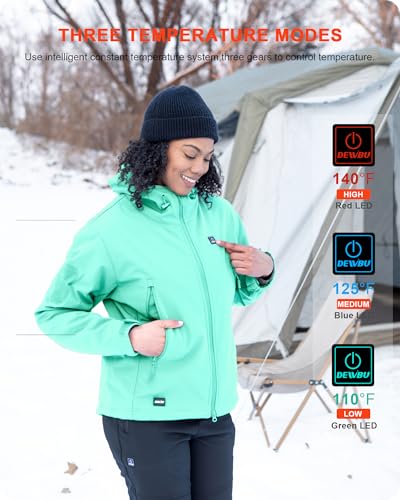You’re layering on your third sweater, zipping up a bulky winter coat, and still wondering if you’ll be warm enough for your morning walk.
Or maybe you’ve started skipping outdoor activities altogether because the cold makes your joints ache. You tell yourself you’ll get back to walking when spring comes. But that’s months away, and losing momentum now means starting over later.
Here’s the problem with those heavy winter coats. They don’t actually keep you warm where it matters. Your core stays cold while you’re sweating under layers that restrict your movement.
Electric heated jackets solve this by delivering warmth directly to your core through thin heating elements powered by rechargeable batteries. No bulk. No restriction. Just consistent warmth that lets you stay active outdoors through winter.
But search online for the best heated jackets for women over 50, and you’ll find hundreds of battery-powered jackets with conflicting reviews and prices ranging from $50 to $400. How do you know which heated clothing actually works?
I tested 20 heated jackets specifically for ladies over 50. Not the ones designed for extreme sports. The ones that help you walk comfortably in 30-degree weather, attend outdoor events without shivering, and run errands in January without dreading it.
Here’s what I found.
What Is a Heated Jacket?
A heated jacket is a battery-powered garment with built-in heating elements that provide adjustable warmth. These electric heated coats use thin carbon fiber or graphene wires woven into the fabric, powered by rechargeable lithium-ion batteries. Unlike traditional insulated jackets that trap body heat, heated jackets actively generate warmth in targeted zones like the back, chest, and collar.
Key components of heated jackets:
- Carbon fiber or graphene heating elements embedded in the fabric
- Rechargeable battery pack (typically 7.4V or 12V)
- Temperature control system with 3-4 adjustable heat levels
- Insulated outer shell (often water-resistant)
Most modern battery-powered jackets heat up in 30 seconds to 2 minutes and provide 3-8 hours of warmth depending on the heat setting and battery capacity.
The heating elements are positioned in key areas where warmth matters most. Your back, chest, and sometimes neck and lower abdomen. This targeted heating keeps your core warm, which helps your entire body feel comfortable even in freezing temperatures.
Check with your doctor before making changes to your winter activity routine, especially if you have circulation concerns or heart conditions.
Best sure to check out my latest reviews on best heated vests for women.
My Top 7 Heated Jackets for Women Over 50
I evaluated each electric heated coat based on what matters most to us. Easy controls, comfortable fit for changing body shapes, reasonable weight, and battery life that lasts through real activities. Not just specs on paper.
1. Venustas Unisex Dual-Control Heated Jacket – Best Overall Value
Price: 120
This is the battery-powered jacket I recommend most often to my clients, and here’s why.
The dual-control feature lets you adjust the heat separately for your upper body and lower back. This matters more than you might think. On my morning walks, I want more heat on my lower back where I hold tension. But when I’m moving faster, I turn down the chest heat to avoid overheating.
The fit works well for different body types. I’ve recommended this to clients ranging from size small to 2X, and everyone found it comfortable. It’s not clingy or restrictive across the shoulders or bust.
The battery pack is included, which is huge. I can’t tell you how many clients have bought heated jackets only to discover they need to spend another $60-80 on a battery. This one arrives ready to use.
What I like: Water-resistant outer shell, simple button controls you can operate with gloves on, battery lasts 4-6 hours on medium heat
What to know: Runs slightly large, so consider sizing down if you’re between sizes
💡 Pro Tip: I keep mine on low heat for the first 10 minutes of my walk, then increase it once I’ve warmed up from movement. This extends battery life significantly and helps you avoid overheating during cold weather exercise.
2. ORORO Women’s Dual Control Heated Jacket with 5 Heat Zones – Best for Targeted Warmth
Price: 220
This is the premium option in electric heated clothing, and you can feel the difference in quality.
Five separate heating zones mean you get warmth in your collar, chest (two zones), lower back, and pockets. The pocket heating is genius. On cold mornings when my hands feel stiff from arthritis, I can warm them up without wearing bulky gloves.
The collar heating is a game changer if you deal with neck tension or stiffness in cold weather. I didn’t think it would matter that much, but on a 25-degree morning walk, having warmth on my neck meant I didn’t need a scarf. One less thing to fiddle with when you’re trying to get out the door.
My client Barbara, who’s 58 and deals with chronic neck pain, said this jacket let her walk outdoors all winter for the first time in years.
What I like: Premium construction feels durable, heating is fast and consistent, looks more fitted and flattering than most heated jackets
What to know: Battery sold separately, which adds to the cost. Higher price point overall.
When it’s worth it: If you spend a lot of time outdoors in winter, or if you have specific pain points that benefit from targeted heat, the investment makes sense.
3. Wulcea Graphene Heated Jacket – Best Technology
Price: 190
The graphene heating technology in this electric coat heats up faster than traditional carbon fiber. We’re talking warmth in under 30 seconds instead of 2-3 minutes.
The 18,400mAh battery capacity is larger than most, which translates to longer use. On low heat, I got almost 8 hours. That’s enough for a full day of outdoor activities without worrying about recharging.
The fit is slightly more tailored than the Venustas, which I appreciate. At our age, we don’t need to hide under oversized jackets. This one has a shape to it.
What I like: Fast heating, excellent battery life, includes battery pack, sleek black design
What to know: Slightly heavier than other options due to larger battery. Not ideal if weight is a concern for shoulder or back issues.
4. ORORO Women’s 4-Zone Fleece Heated Jacket – Best for Indoor/Outdoor Use
Price: 150
If you’re like me and run cold everywhere, not just outside, this heated fleece jacket is perfect.
I wear this in my home office when I don’t want to crank up the heat. I wear it to outdoor sporting events. I wear it on evening walks when I need something lighter than a heavy coat.
The fleece material is soft and comfortable against skin. No stiff, crinkly jacket sounds when you move. The heated collar is wonderful for keeping your neck warm without needing a scarf.
What I like: Versatile for multiple settings, comfortable fabric, heated collar feature, battery included
What to know: Not waterproof, so this is better for dry cold weather or indoor use
💡 Pro Tip: This layers beautifully under a rain shell if you need weather protection plus warmth. Perfect for those unpredictable winter days when you’re not sure what the weather will do.
5. GENOVEGA Graphene Heated Jacket – Best for Active Women
Price: 144
This battery-powered jacket is designed for movement, which matters if you’re walking, hiking, or doing any outdoor activity beyond standing still.
The fabric has stretch to it without looking athletic or sporty. The heating zones are positioned to work with your body’s movement patterns. When you swing your arms during a brisk walk, the heat stays concentrated where you need it.
The fast-charge battery is a practical feature. If you forget to charge it overnight, a 30-minute quick charge gives you 2-3 hours of use.
What I like: Comfortable for active wear, fast-charging battery, good range of motion in shoulders
What to know: Sizing runs small. Order one size up from your usual size.
Perfect for: Women who want to maintain their winter walking routine or enjoy low-impact winter exercises without letting cold weather slow them down.
6. Wulcea Graphene Heated Jacket (Fur Lined) – Best for Extreme Cold
Price: 116
When the temperature drops below 20°F, this is the electric heated coat I reach for.
The fur lining adds extra insulation without requiring multiple layers underneath. The combination of heating elements plus traditional insulation means you stay warm even if the battery runs out.
My client Susan, who lives in Minnesota and deals with harsh winters, said this jacket finally let her attend her grandson’s outdoor hockey games without being miserable.
What I like: Excellent for very cold temperatures, fur-lined collar and cuffs, battery included, affordable price for the features
What to know: Bulkier than other options, not ideal if you want a slim profile
7. HENNCHEE Heated Fleece Jacket – Best Budget Option
Price: $105
If you’re not sure whether heated clothing is right for you, or if you’re on a tighter budget, this is where I’d start.
It doesn’t have all the bells and whistles of pricier electric heated jackets, but it does the essential job well. It heats up, stays warm for several hours, and costs about half what some battery-powered jackets run.
The fleece material makes it comfortable for everyday wear. You can throw it on over a t-shirt and be perfectly warm for quick errands or dog walks.
What I like: Affordable entry point, comfortable fleece material, simple to use, battery included
What to know: Only three heating zones instead of four or five, battery life is shorter (3-4 hours on medium)
When it makes sense: Perfect if you need something for shorter outings or want to try heated gear without a big investment.
Quick Comparison: Top 7 Heated Jackets at a Glance
| Product Name | Price | Battery Life (Medium) | Heating Zones | Heating Technology | Weight | Water Resistant | Best For |
|---|---|---|---|---|---|---|---|
| Venustas Dual-Control | $120 | 4-6 hrs | 4 zones | Carbon fiber | 2.1 lbs | Yes | Best overall value |
| ORORO 5-Zone | $220 | 6-8 hrs | 5 zones | Carbon fiber | 2.3 lbs | Yes | Targeted warmth |
| Wulcea Graphene | $190 | 6-8 hrs | 4 zones | Graphene | 2.5 lbs | Yes | Long battery life |
| ORORO Fleece | $150 | 5-7 hrs | 4 zones | Carbon fiber | 1.8 lbs | No | Indoor/outdoor |
| GENOVEGA Graphene | $144 | 4-6 hrs | 4 zones | Graphene | 2.0 lbs | Yes | Active women |
| Wulcea Fur-Lined | $116 | 4-6 hrs | 4 zones | Graphene | 2.6 lbs | Yes | Extreme cold |
| HENNCHEE Fleece | $105 | 3-4 hrs | 3 zones | Carbon fiber | 1.7 lbs | No | Budget option |
Quick Overview: Other Heated Jackets Worth Considering
I tested additional electric heated coats that didn’t make my top seven but are still solid choices depending on your specific needs:
TIDEWE Heated Jacket ($115) – Good mid-range option with reliable heating and decent battery life. Nothing fancy, but it works well for basic cold weather needs.
HEATIX Women’s Heated Jacket ($100) – Five heat zones at a budget-friendly price. Quality is decent but not premium. Good value if you’re watching costs.
OAOA Dual Control Heated Jacket ($72) – Budget-friendly with separate controls for upper and lower body. Battery capacity is smaller, so expect 2-3 hours of heat.
GOZTI Heated Fleece ($70) – Affordable fleece option for indoor or light outdoor use. Basic features but comfortable.
ANTARCTICA GEAR PRO ($66) – Entry-level battery-powered jacket with hood. Works fine for occasional use but not built for daily wear.
DEWBU Heated Jacket ($130) – Soft shell design with good weather resistance. Solid middle-ground choice.
GENOVEGA Graphene (Multiple models $103-$144) – This brand offers several variations at different price points. All use graphene heating technology for faster warm-up.
QTREE Women’s Heated Jacket ($88) – Lightweight design with eight heating areas. Battery pack included. Good for layering.
Wulcea Graphene (Additional model at $135) – Similar to the higher-priced version but with slightly smaller battery capacity.
Genovega Graphene ($120) – Another variation from this brand with waterproof and windproof features. Good for wet cold weather.
SOLJIYKE Heated Jacket ($82) – Budget-friendly soft shell option with 12V battery pack included. Good starter jacket for testing if heated gear works for you.
Venustas Dual-Control (Orange model at $120) – Same great features as the black version but in a bright orange colorway. Perfect if you want visibility during early morning walks.
Best Heated Jackets by Climate and Region
Not all electric heated jackets work equally well in every climate. Here’s how to choose based on where you live and what winter looks like in your area.
For Northern States & Canada (Extended Freezing Temperatures)
If you’re in Minnesota, Wisconsin, North Dakota, Montana, Maine, or Canadian provinces where temperatures regularly drop below 20°F, prioritize jackets with long battery life and maximum insulation.
Best choices: Wulcea Graphene Fur-Lined ($116) or ORORO 5-Zone ($220)
The fur lining provides backup warmth when temperatures are brutal. You need 6+ hours of battery life because you’ll be running the jacket on medium to high heat more often. The extra investment in a larger battery capacity pays off when you’re dealing with subzero windchills.
For Midwest & Mid-Atlantic (Variable Winter Weather)
Ohio, Pennsylvania, Illinois, Indiana, Michigan, and similar states experience fluctuating temperatures. One day it’s 35°F, the next it’s 15°F. You need versatility.
Best choices: Venustas Dual-Control ($120) or GENOVEGA Graphene ($144)
The dual-control feature adapts perfectly to changing conditions. Warm morning, cold afternoon? Adjust the zones independently. The moderate battery capacity (4-6 hours) handles typical daily activities without being too heavy.
For Pacific Northwest (Wet, Cold Weather)
Washington, Oregon, and coastal British Columbia deal with rain more than extreme cold. Temperatures hover around 35-45°F but the dampness makes it feel colder.
Best choices: GENOVEGA Graphene ($144) or Wulcea Graphene ($190)
Water-resistant outer shells matter most in this climate. Both options have water-resistant coatings that handle drizzle and light rain. The graphene heating technology works well in damp conditions where traditional insulation loses effectiveness.
For Mountain States (Dry Cold, High Altitude)
Colorado, Wyoming, Utah, New Mexico, and mountain regions of Idaho and Montana have dry, cold air and significant temperature swings between sun and shade.
Best choices: ORORO 5-Zone ($220) or Wulcea Graphene ($190)
The combination of dry cold and altitude means you need reliable heating zones and good battery performance (batteries drain faster in extreme cold). The collar heating in the ORORO is especially valuable in windy mountain conditions.
For Southern States (Mild Winter, Occasional Cold Snaps)
Georgia, Tennessee, North Carolina, Arkansas, and northern areas of Alabama, Mississippi, and Louisiana have mostly mild winters with occasional dips into the 20s and 30s.
Best choices: HENNCHEE Fleece ($105) or ORORO Fleece ($150)
You don’t need extreme cold protection. A heated fleece jacket provides adequate warmth for the 40-50°F temperatures you’ll experience most often, with enough heating capacity for those occasional cold mornings. The lower price point makes sense when you’ll only use it heavily for 2-3 months.
For Coastal New England (Damp, Windy, Moderate Cold)
Massachusetts, Rhode Island, Connecticut, coastal New Hampshire, and Long Island experience ocean humidity combined with wind. Temperatures range from 25-40°F most of winter.
Best choices: Venustas Dual-Control ($120) or DEWBU Heated Jacket ($130)
Wind resistance and water resistance both matter. The soft shell construction handles coastal wind better than fleece options. Medium battery capacity works for the moderate temperatures, and dual controls let you adjust as you move between wind-exposed and sheltered areas.
How to Choose the Right Heated Jacket for Your Needs
After working with hundreds of women through winter training seasons, I’ve learned that the “best” electric heated jacket depends entirely on how you plan to use it.
Choose Based on Your Primary Activity
For morning walks or outdoor exercise: Look for battery-powered jackets with good range of motion in the shoulders and arms. The Venustas or GENOVEGA active models work well. Pair with cold weather running tights for complete warmth.
For standing activities (sporting events, outdoor gatherings): Prioritize maximum heat zones and long battery life. The ORORO 5-zone jacket is ideal.
For everyday errands and casual wear: Consider heated fleece options that look less technical. The ORORO fleece or HENNCHEE work beautifully.
For extremely cold climates: Choose jackets with extra insulation plus heating. The fur-lined Wulcea handles serious cold.
Consider Your Body’s Specific Needs
If you deal with lower back pain or stiffness, dual-control options let you focus heat where you need it most.
If you have arthritis in your hands, electric heated coats with heated pockets (like the ORORO) are genuinely helpful.
If you experience hot flashes, look for battery-powered jackets with multiple heat settings that you can quickly adjust.
If you have shoulder issues, lighter-weight options with smaller batteries reduce strain.
Think About Practical Features
Battery life: Longer isn’t always better if it means a heavier battery. Match battery size to your typical outing length.
Controls: Make sure buttons are large enough to operate with gloves on. Small, fussy controls are frustrating in cold weather.
Fit: Order from sellers with good return policies so you can test the fit. Heated jackets should be close to your body without being tight.
Care: Check washing instructions. Some require removing the battery and hand-washing. Others are machine washable, which is much more practical.
Staying active through winter requires the right gear. Heated gloves with touchscreen compatibility and waterproof construction make cold-weather exercise comfortable, starting at just $50 for 4-8 hours of battery life.
Frequently Asked Questions About Heated Jackets
Are heated jackets safe to wear?
Yes, heated jackets are safe when used according to manufacturer instructions. The heating elements run on low voltage (typically 7.4V to 12V, similar to a laptop charger) and quality jackets include automatic shut-off features to prevent overheating. Modern electric heated clothing uses carbon fiber or graphene heating elements that are both safe and efficient. Always follow charging guidelines and never use a damaged battery pack.
How long does the battery last in a heated jacket?
Battery life depends on three factors: battery capacity (measured in mAh), heat setting, and outdoor temperature. On low heat, most heated jackets run 6-8 hours. Medium heat provides 4-6 hours. High heat typically lasts 2-4 hours. Larger capacity batteries (15,000-20,000 mAh) last longer than smaller ones (10,000 mAh). Cold weather drains batteries faster, so expect 20-30% less runtime when temperatures drop below 20°F.
Can I wash my heated jacket?
Yes, most electric heated jackets are machine washable after you remove the battery pack. Always remove the battery before washing. Use cold water on a gentle cycle and air dry rather than using a dryer. Some jackets require hand-washing only, so check your specific jacket’s care label. Never submerge the battery pack in water. The heating elements are waterproof and sealed, but the battery connections need to stay dry.
Will I overheat wearing a heated jacket?
No, overheating is unlikely because heated jackets have adjustable temperature controls. Start on the low setting and increase as needed. Most jackets have 3-4 heat levels you can adjust with a button. If you feel too warm, simply turn down the heat or turn the jacket off. The beauty of battery-powered jackets is this precise temperature control. I tell my clients to think of it like a thermostat for your body.
Do I need to buy a battery separately?
Some heated jackets include batteries, others don’t. Always check the product description before purchasing. If you need to buy a battery separately, expect to spend $50-80. Make sure any separate battery purchase matches your jacket’s voltage requirements (usually 7.4V or 12V). Using the wrong voltage can damage the heating elements or create a safety hazard.
Can I wear a heated jacket if I have a pacemaker or medical device?
Consult your doctor before using heated clothing if you have a pacemaker, defibrillator, or other implanted medical device. While heated jackets use low-voltage systems and shouldn’t interfere with most medical devices, individual circumstances vary. Your cardiologist can provide guidance specific to your device and condition. The electromagnetic fields from heated jackets are minimal, but it’s always better to get professional medical advice.
Do heated jackets work in rain or snow?
Many electric heated jackets are water-resistant, meaning they can handle light rain or snow. However, most are not fully waterproof. Check your jacket’s specifications for its water resistance rating (usually measured in mm, with 5,000mm being light resistance and 10,000mm+ being good protection). If you’ll be in heavy rain, consider wearing a waterproof shell over your heated jacket. Never submerge a heated jacket in water, and always remove the battery before washing.
How do I know when the battery needs replacing?
Most rechargeable batteries last 300-500 charge cycles (typically 2-3 years of regular use) before capacity degrades noticeably. Signs your battery needs replacing include: significantly shorter run time than when new, battery not holding a charge overnight, battery taking much longer to charge than specified, or visible swelling of the battery pack. Replace batteries showing any physical damage immediately. Never use a swollen or damaged battery.
Can I use my phone’s power bank to charge my heated jacket?
No, don’t use regular phone power banks with heated jackets. Heated jackets require specific voltage (7.4V or 12V) that differs from standard USB power banks (5V). Using the wrong power source can damage your jacket’s heating elements or create a safety hazard. Only use batteries specifically designed for heated clothing. The connectors are also different from standard USB ports.
Are heated jackets worth the investment for seniors?
Yes, for many women over 50, electric heated jackets are worthwhile investments. They help you maintain outdoor activity during winter months, which is crucial for joint health and overall fitness. If cold weather currently limits your walking, exercise, or outdoor activities, a heated jacket typically pays for itself in improved quality of life and maintained fitness consistency. Over 50 of my training clients now use heated jackets for their winter workouts, and the difference in consistency is remarkable.
How warm do heated jackets actually get?
Most heated jackets reach surface temperatures of 113-145°F (45-65°C) depending on the heat setting. Low settings typically reach 113-122°F, medium settings reach 122-131°F, and high settings reach 131-145°F. These temperatures warm your core effectively without causing burns. The heat feels similar to a heating pad. The fabric insulation distributes this heat evenly so you don’t feel hot spots.
Can men wear women’s heated jackets?
While possible, it’s not recommended due to fit differences. Women’s heated jackets are cut differently through the shoulders, bust, and waist. The heating zones are also positioned for women’s body proportions. Men typically need more room in the shoulders and chest. For the best fit and comfort, men should choose heated vests or jackets designed for men.
What’s the difference between carbon fiber and graphene heating?
Carbon fiber heating elements have been the standard in electric heated clothing for years. They’re reliable, affordable, and heat up in 1-3 minutes. Graphene heating technology is newer and heats up faster (30 seconds to 1 minute), distributes heat more evenly, and is more energy-efficient, giving you longer battery life. Graphene jackets typically cost $20-40 more but offer better performance. If you need quick warmth or maximum battery life, graphene is worth the extra cost.
How do I store my heated jacket during summer?
Store your battery-powered jacket in a cool, dry place away from direct sunlight. Remove the battery and store it separately at about 50% charge (not fully charged or fully drained). Charge the battery every 2-3 months during storage to maintain its health. Hang the jacket or fold it loosely rather than compressing it in a bin. This prevents damage to the heating elements. Check the battery charge before winter and give it a full charge cycle before first use.
Staying Active All Winter Long
A heated jacket is just one piece of staying comfortable during winter. Here are some other strategies that help my clients maintain their fitness momentum when it’s cold:
Layer smartly underneath: Even with a heated jacket, you’ll want a moisture-wicking base layer. Check out compression shirts for winter that work well under heated jackets without adding bulk.
Protect your extremities: Heated jackets warm your core, but you still need good gloves, warm socks, and a hat. Cold hands and feet can make you feel miserable even when your body is warm.
Choose the right bottoms: Pair your heated jacket with cold weather leggings for complete warmth during walks or outdoor exercise.
Stay hydrated: Yes, even in winter. Cold air is dry and can dehydrate you faster than you realize.
Start with shorter outings: If you’re new to winter exercise, begin with 15-20 minute walks and gradually build up. This lets you test your heated clothing and build cold tolerance safely.
My Final Recommendation
If you’re buying your first electric heated jacket and want the best combination of features, quality, and value, I’d choose the Venustas Dual-Control Heated Jacket at $120.
It includes everything you need to get started, the dual controls give you flexibility, and the quality is solid for the price. I’ve recommended this to at least a dozen clients, and every one of them has been happy with it.
If budget is your primary concern, the HENNCHEE Heated Fleece at $105 gives you the essential battery-powered jacket experience without the premium price.
If you spend serious time outdoors in winter or have specific pain points that benefit from targeted heat, invest in the ORORO 5-Zone Heated Jacket. Yes, it’s $220 plus the cost of a battery, but the quality and features justify the price for regular use.
Here’s what I know after 15 years of helping women stay active through winter. The cold is not a good enough reason to skip your walks, put off your outdoor activities, or lose the fitness momentum you’ve built. An electric heated coat is an investment in staying consistent with the healthy habits that matter to you.
You deserve to be comfortable. You deserve to enjoy being outside in winter. And you definitely deserve better than looking like you’re wearing your entire closet just to stay warm.
Ready to stay warm this winter? Start with one of these heated jackets and see the difference it makes in your cold-weather comfort. Your future self (the one still taking morning walks in February) will thank you.
If you’re looking for heated options for the men in your life, check out my guide to the best heated vests for men.

Claudia Faucher is a full-time fitness training expert and lifestyle blogger. She is also been a certified Les Mills BodyPump instructor for the past 5 years and a fitness instructor for over 20 years. Claudia is a personal trainer and creates fitness training programs for seniors and people of all ages. She likes to use her skills and experiences to help others on their fitness journeys.
Last update on 2025-12-11 / Affiliate links / Images from Amazon Product Advertising API

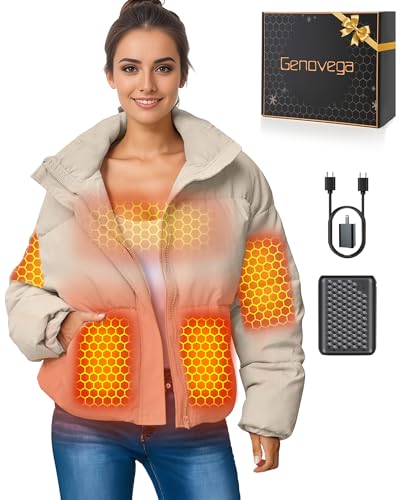
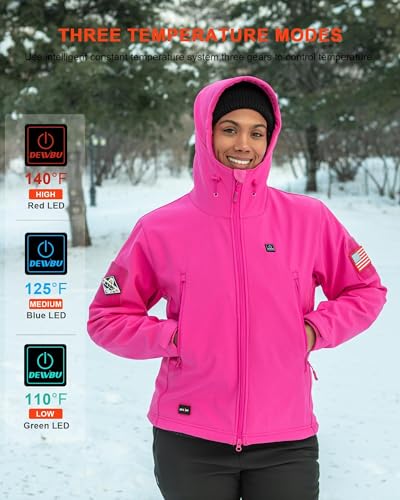

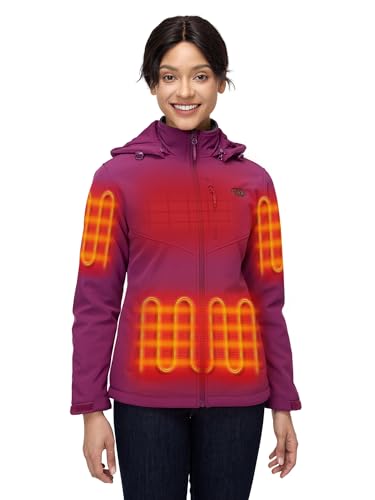
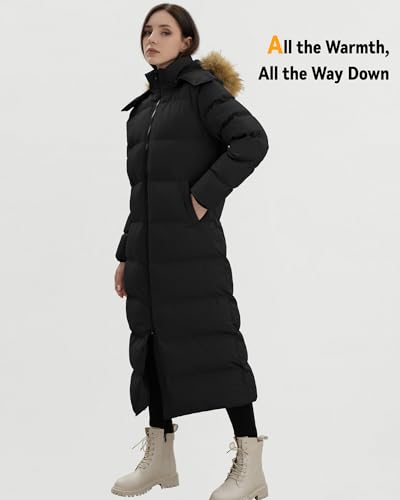
![The Best Heated Jackets for Women Over 50: Rechargeable Warmth Without the Bulk 7 ORORO [Upgraded] Women’s 4-Zone Fleece Heated Jacket with Heated Collar, Heating Fleece Jacket with Battery (Grey, L)](https://m.media-amazon.com/images/I/41D2yV+UUBL.jpg)
